battery SAAB 9-3 2000 Owners Manual
[x] Cancel search | Manufacturer: SAAB, Model Year: 2000, Model line: 9-3, Model: SAAB 9-3 2000Pages: 236, PDF Size: 10.85 MB
Page 6 of 236
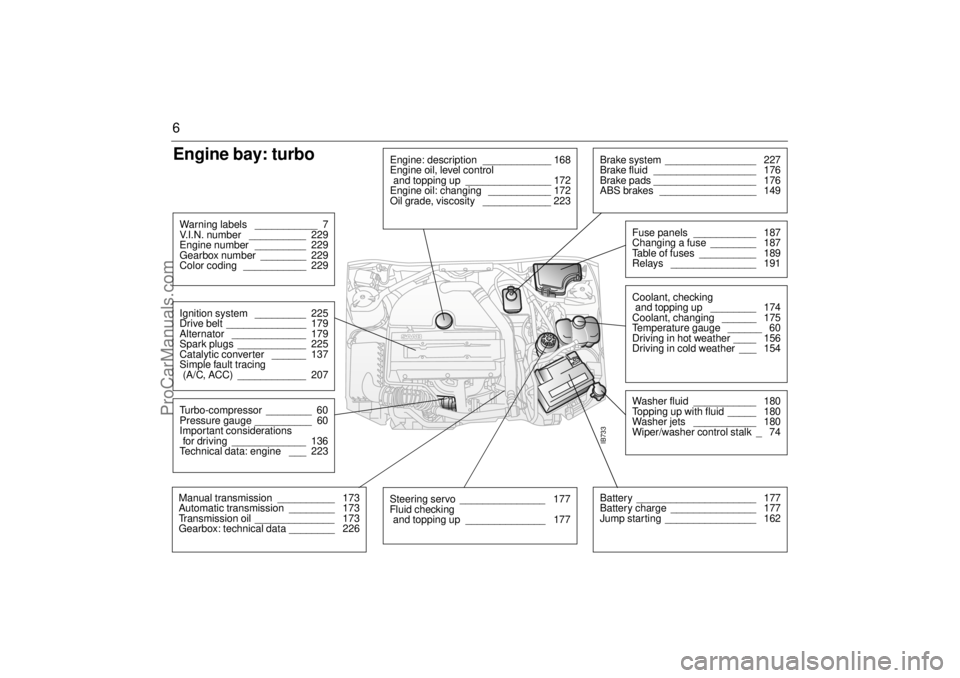
6Engine bay: turboWarning labels ___________ 7
V.I.N. number __________ 229
Engine number _________ 229
Gearbox number ________ 229
Color coding ___________ 229Ignition system _________ 225
Drive belt ______________ 179
Alternator _____________ 179
Spark plugs ____________ 225
Catalytic converter ______ 137
Simple fault tracing
(A/C, ACC) ____________ 207Turbo-compressor ________ 60
Pressure gauge __________ 60
Important considerations
for driving _____________ 136
Technical data: engine ___ 223Manual transmission __________ 173
Automatic transmission ________ 173
Transmission oil ______________ 173
Gearbox: technical data ________ 226
Battery _____________________ 177
Battery charge _______________ 177
Jump starting ________________ 162IB733
Engine: description ____________ 168
Engine oil, level control
and topping up _______________ 172
Engine oil: changing ___________ 172
Oil grade, viscosity ____________ 223
Washer fluid ___________ 180
Topping up with fluid _____ 180
Washer jets ___________ 180
Wiper/washer control stalk _ 74
Steering servo _______________ 177
Fluid checking
and topping up ______________ 177
Coolant, checking
and topping up ________ 174
Coolant, changing ______ 175
Temperature gauge ______ 60
Driving in hot weather ____ 156
Driving in cold weather ___ 154Fuse panels ___________ 187
Changing a fuse ________ 187
Table of fuses __________ 189
Relays _______________ 191
Brake system ________________ 227
Brake fluid __________________ 176
Brake pads __________________ 176
ABS brakes _________________ 149
ProCarManuals.com
Page 7 of 236
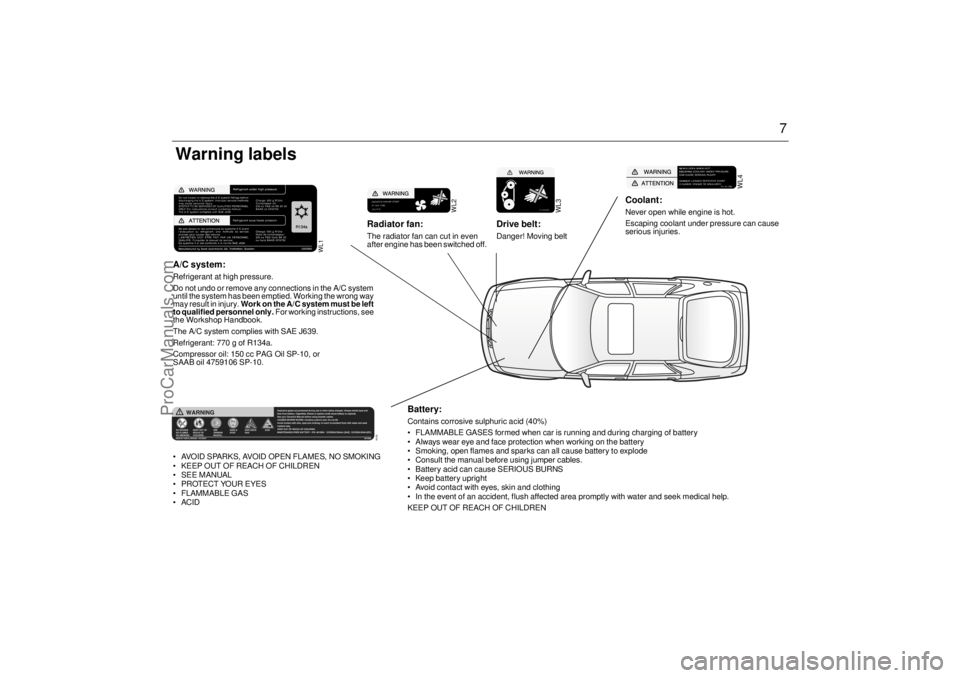
7
WL4
Coolant: Never open while engine is hot.
Escaping coolant under pressure can cause
serious injuries.
WL3
Drive belt: Danger! Moving belt
WL2
Radiator fan: The radiator fan can cut in even
after engine has been switched off.
Battery: Contains corrosive sulphuric acid (40%)
FLAMMABLE GASES formed when car is running and during charging of battery
Always wear eye and face protection when working on the battery
Smoking, open flames and sparks can all cause battery to explode
Consult the manual before using jumper cables.
Battery acid can cause SERIOUS BURNS
Keep battery upright
Avoid contact with eyes, skin and clothing
In the event of an accident, flush affected area promptly with water and seek medical help.
KEEP OUT OF REACH OF CHILDREN
Warning labels
WL1
A/C system: Refrigerant at high pressure.
Do not undo or remove any connections in the A/C system
until the system has been emptied. Working the wrong way
may result in injury. Work on the A/C system must be left
to qualified personnel only. For working instructions, see
the Workshop Handbook.
The A/C system complies with SAE J639.
Refrigerant: 770 g of R134a.
Compressor oil: 150 cc PAG Oil SP-10, or
SAAB oil 4759106 SP-10.
WL36
AVOID SPARKS, AVOID OPEN FLAMES, NO SMOKING
KEEP OUT OF REACH OF CHILDREN
SEE MANUAL
PROTECT YOUR EYES
FLAMMABLE GAS
ACID
ProCarManuals.com
Page 17 of 236

17 Safety
WARNING
Safety belts are designed to bear upon
the bony structure of the body, and should
be worn low across the front of the pelvis
or the pelvis, chest and shoulders, as
applicable; wearing the lap section of the
belt across the abdominal area must be
avoided.
Safety belts should be adjusted as firmly
as possible, consistent with comfort, to
provide the protection for which they have
been designed. A loose belt will greatly
reduce the protection afforded to the
wearer.
Care should be taken to avoid contamina-
tion of the webbing with polishes, oils and
chemicals, and particularly battery acid.
Cleaning may safely be carried out using
mild soap and water. The belt should be
replaced if webbing becomes frayed,
contaminated or damaged.
It is essential to replace the entire assem-
bly after it has been worn in a severe
impact even if damage to the assembly is
not obvious.
Belts should not be worn with straps
twisted.
Each belt assembly must only be used by
one occupant; it is dangerous to put a belt
around a child being carried on the occu-
pant´s lap.
WARNING
No modifications or additions should be
made by the user which will either prevent
the safety belt adjusting device from oper-
ating to remove slack, or prevent the
safety belt assembly from being adjusted
to remove slack.
ProCarManuals.com
Page 25 of 236

25 Safety
Scrapping or working on airbag and
belt pretensioners Frequently asked questions on func-
tion of the airbag
Do you still need to wear a
safety b
elt if air-
bags are fitted?
Yes, always! The airbag merely supple-
ments the car’s normal safety system.
Moreover, the airbag will only be actuated in
a moderate to severe frontal, or near-frontal
collision, which means, of course, that it pro-
vides no protection in minor frontal colli-
sions, major rear-end or side-on collisions
or if the car rolls over.
The safety belts help reduce the chance of
the car occupants from being thrown around
and injured inside the car.
But they also ensure that, if a collision
occurs in which the airbags are inflated, the
airbag will make the optimum contact with
the occupant, i.e. square on from the front.
If the occupant meets the airbag in an offset
position, the protection afforded will be
reduced.
In addition, airbags provide no protection
against a secondary impact occurring in the
same incident. So there is no doubt about
the benefit of wearing safety belts at all
times.
Do not sit too close to the airbag: it needs
room to inflate.
The airbag inflates very quickly and power-
fully in order to protect an adult person in a
serious frontal collision.
How do I position the seat to leave room for
the airbag to inflate?Don’t have your seat too far forward.
Recline the seat back to increase the dis-
tance between you and the airbag. For short
drivers, special accessory pedal extensions
are available through your Saab dealer.
Airbags inflate extremely rapidly and with
great force - to be fast enough to protect an
adult in the seat. When does the airbag inflate? The airbag will only be inflated under certain
predetermined conditions in a moderate to
severe frontal, or near-frontal collision,
depending on such factors as the force and
angle of the impact, the speed of the car on
impact, and the resistance to deformation of
the impacting object.
The airbag can only be activated once in the
same incident.
Do not attempt to drive the car after an
airbag has been inflated, even if it is possi-
ble. What won’t trigger the airbag? The airbag will not be activated in all
front-end collisions. For instance, if the car
has hit something relatively soft and yielding
(e.g. a snow drift or a hedge) or a solid
object at a low impact speed, the airbag will
not necessarily be triggered.
WARNING
Under no circumstances should any
modifications be made that affect the
steering wheel or the airbag’s electri-
cal circuitry.
Before starting any welding work on
the car, always disconnect the nega-
tive (–) battery lead and cover the con-
ductor.
Airbags and belt pretensioners must
be deployed under controlled condi-
tions before the car is scrapped or any
of the system’s components are
removed. Airbags or belt pretension-
ers that have been deployed as a
result of an accident must be replaced
by new ones.
Airbag-system components must
never be transferred for use in another
vehicle.
All work involving the scrapping or
replacement of airbags or belt preten-
sioners must only be carried out by
knowledgeable personnel.
ProCarManuals.com
Page 32 of 236
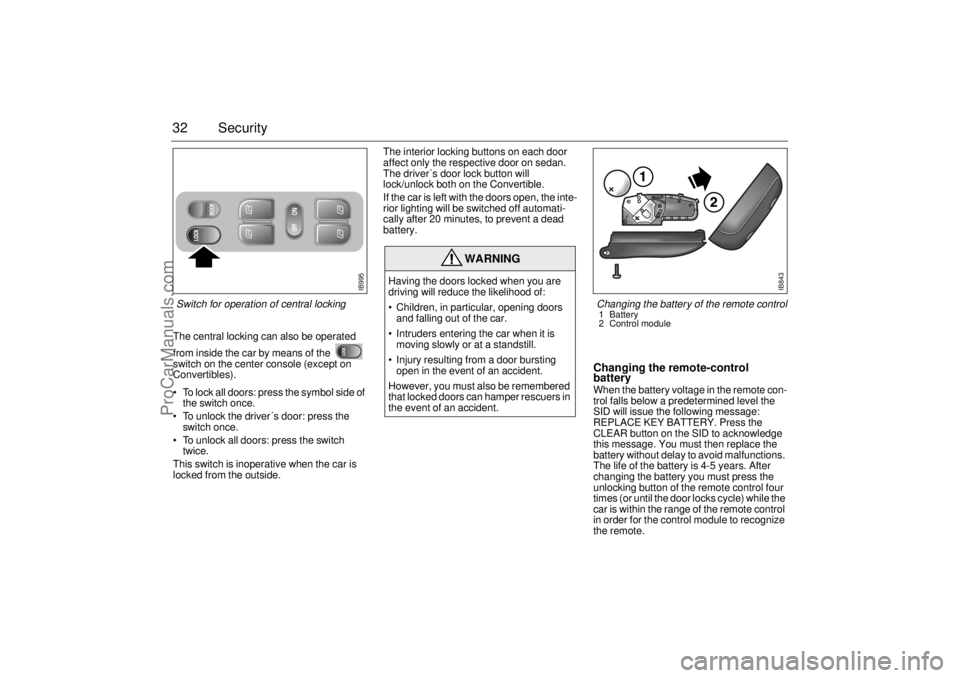
32 SecurityThe central locking can also be operated
from inside the car by means of the
switch on the center console (except on
Convertibles).
To lock all doors: press the symbol side of
the switch once.
To unlock the driver´s door: press the
switch once.
To unlock all doors: press the switch
twice.
This switch is inoperative when the car is
locked from the outside.The interior locking buttons on each door
affect only the respective door on sedan.
The driver´s door lock button will
lock/unlock both on the Convertible.
If the car is left with the doors open, the inte-
rior lighting will be switched off automati-
cally after 20 minutes, to prevent a dead
battery.
Changing the remote-control
batteryWhen the battery voltage in the remote con-
trol falls below a predetermined level the
SID will issue the following message:
REPLACE KEY BATTERY. Press the
CLEAR button on the SID to acknowledge
this message. You must then replace the
battery without delay to avoid malfunctions.
The life of the battery is 4-5 years. After
changing the battery you must press the
unlocking button of the remote control four
times (or until the door locks cycle) while the
car is within the range of the remote control
in order for the control module to recognize
the remote.
WARNING
Having the doors locked when you are
driving will reduce the likelihood of:
Children, in particular, opening doors
and falling out of the car.
Intruders entering the car when it is
moving slowly or at a standstill.
Injury resulting from a door bursting
open in the event of an accident.
However, you must also be remembered
that locked doors can hamper rescuers in
the event of an accident.
IB995
Switch for operation of central locking
IB843
Changing the battery of the remote control1Battery
2 Control module
ProCarManuals.com
Page 33 of 236
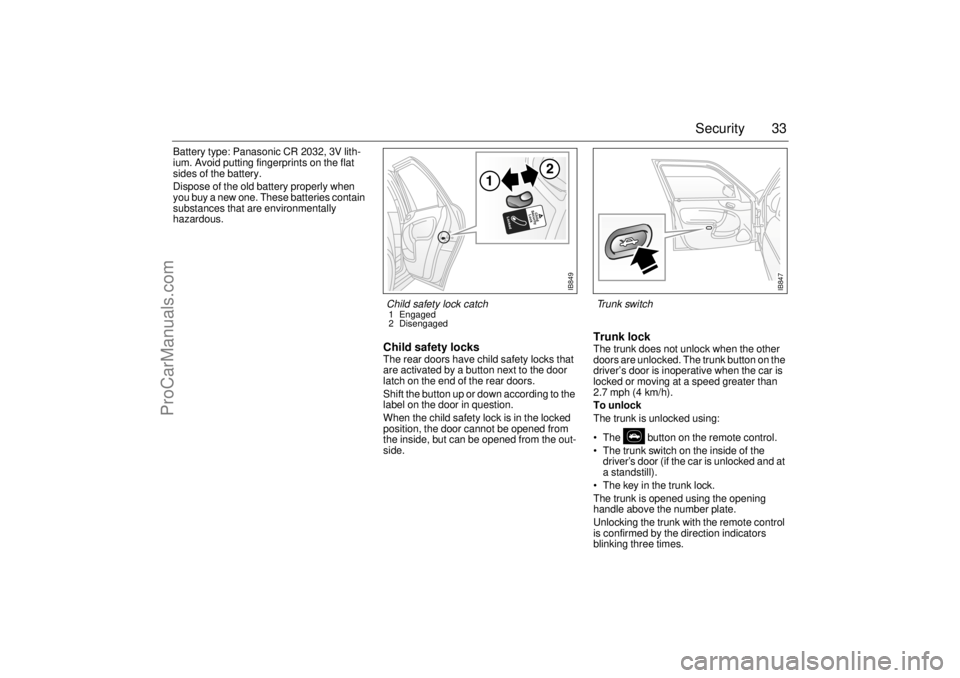
33 Security
Battery type: Panasonic CR 2032, 3V lith-
ium. Avoid putting fingerprints on the flat
sides of the battery.
Dispose of the old battery properly when
you buy a new one. These batteries contain
substances that are environmentally
hazardous.
Child safety locksThe rear doors have child safety locks that
are activated by a button next to the door
latch on the end of the rear doors.
Shift the button up or down according to the
label on the door in question.
When the child safety lock is in the locked
position, the door cannot be opened from
the inside, but can be opened from the out-
side.
Trunk lockThe trunk does not unlock when the other
doors are unlocked. The trunk button on the
driver’s door is inoperative when the car is
locked or moving at a speed greater than
2.7 mph (4 km/h).
To unlock
The trunk is unlocked using:
The button on the remote control.
The trunk switch on the inside of the
driver’s door (if the car is unlocked and at
a standstill).
The key in the trunk lock.
The trunk is opened using the opening
handle above the number plate.
Unlocking the trunk with the remote control
is confirmed by the direction indicators
blinking three times.
IB849
Child safety lock catch 1 Engaged
2 Disengaged
IB847
Trunk switch
ProCarManuals.com
Page 37 of 236

37 Security
Alarm signals When the car alarm is armed, it will be trig-
gered if any door, the trunk lid or hood, is
opened, or if a window is broken.
The alarm will also be triggered if an attempt
is made to bypass or short-circuit the igni-
tion switch, or to disconnect the battery.
If the alarm is triggered, the following alarm
signals will be set off:
Flashing of hazard warning lights for five
minutes.
Siren wailing for 30 seconds.
The alarm signals will stop if the alarm is
deactivated (car unlocked) during the alarm
period.
Panic-functionIn the car alarm system is a function called
"Panic-function".
To activate panic function:
Push and hold one of the buttons on the
remote control for 2 seconds, or if you are
sitting inside the car...
Push the LOCK-switch on the center con-
sole for 2 seconds (not Convertibles).
These actions will trigger the alarm (hazard
warning lights and siren).
To deactivate panic function:
Push one of the buttons on the remote
control, push the LOCK-switch in the
center console, turn the key in one of the
doors or turn the ignition to ON.
When the panic-function is activated the car
will be locked/unlocked depending upon
which button was pushed.
When the ignition is ON the panic-function
cannot be activated.
NOTE It is possible to inadvertently deacti-
vate the car alarm and at the same
time unlock the car, if the button on the
remote control is pressed by mistake
when the control is still within range of
the car.
When locking the car by remote con-
trol in extremely cold weather, it is
advisable to check that the lock
system has operated properly. To do
so, check that the interior locking but-
tons are all down.
If not, unlock and relock the car again.
ProCarManuals.com
Page 38 of 236

38 SecurityOverview of functions
Alarm signals may differ between model variants for different coun-
tries.
Some of the car-alarm functions can be reprogrammed – con-
sult your Saab dealer for further details (see page 231). Locking/
activation Hazard warning lights flash once (0.5 seconds).
Horn chirps once.
The LED will come on for 10 seconds.
Unlocking/
deactivation Hazard warning lights flash twice.
Horn chirps twice.
The LED will come on for two seconds.
Unlocking/
deactivation of
trunk lid alarm Hazard warning lights flash three times.
Horn chirps three times.
The LED will flash three times per second for 10
seconds.
Alarm triggered Hazard warning lights flash for 5 min.
Siren wails for 30 seconds.
To switch off the alarm, deactivate the system in
the normal way (unlocking) by unlocking the
door with the key or the remote
Window-glass
sensor The sensor detects if any window is broken and
triggers the alarm.
To disable the sensor, see page 36.
Remote control The range of the remote control is normally
5-10 yds. (5-10 metres), although it can be sub-
stantially more than this in ideal conditions.
If a remote control is lost, the new one will have
to be programmed from one of the remaining
remote controls to match the car’s unique secu-
rity code. Get in touch with an authorized Saab
dealer. Your dealer will need your second remote
to program a new one
If another remote or key is desired (up to total of
4), all keys and remotes must be present when
programming additional ones.Battery for
remote control The battery for the remote control will normally
have a life of 4-5 years. When the battery needs
changing, ”REPLACE KEY BATTERY” will
appear on the SID.
After fitting a new battery, press the unlock but-
ton on the remote control at least four times in
succession, so that the car alarm can recognize
the signals from the transmitter.
If the remote control has been exposed to very
low temperatures, it may not function properly. If
this happens, warm it in your hands for a few
minutes.
If the remote control is not working, it may be
because the code signal has not been synchro-
nized with that in the control module for the car
alarm. To rectify this, press the unlock button on
the remote control at least four times in quick
succession. When it is recognized, the door
locks will cycle.
Car-battery
voltage If the car-battery voltage is lost while the alarm is
activated - for instance, if the battery has died -
the car alarm will be deactivated. Once battery
voltage is present again, the alarm will revert to
its status at the time the voltage went down.
If the battery is disconnected, e.g. in an attempt
to break into the car, the alarm will be triggered
ProCarManuals.com
Page 39 of 236

39 Security
Overview of, LED signals and SID messagesSome signals may differ between model variants for different
countries.Status LED signal
Activation (during 10-second delay). Comes on for 10 seconds.
Alarm activated (after delay). Flashes once every third
second.
Deactivation. Comes on for 2 seconds.
Alarm not activated. Off.
Door, trunk lid or hood open or
opened during delay period.Flashes three times per sec-
ond for 10 seconds.
Unlocking the trunk lid. Flashes three times per sec-
ond for 10 seconds.
Closing of door, trunk lid or hood
after delay period.Comes on for 10 seconds.
Car immobilized but not locked.
Car alarm not activated.Flashes twice at three sec-
onds intervals.
Fault in a switch serving doors, hood
or trunk lid.Flashing (instead of being
on continuously) during
delay period.
SID message Reason/action
SERVICE THEFT ALARM Probably a faulty sensor or siren.
Have the car checked by an autho-
rized Saab dealer.
KEY NOT ACCEPTED Fault in key transmitter or in igni-
tion-switch receiver. Turn ignition
switch to ON and press one of the
buttons on the remote control. Start
the engine.
Have the car checked by an autho-
rized Saab dealer.
REPLACE KEY BATTERY Fit a new battery in the remote con-
trol.
DOOR ALARM ONLY Window-glass sensor is disabled.
FULL THEFT ALARM Window-glass sensor is included in
circuit.
REMOTE KEY
TRANSPONDRTurn the ignition key to position ON
and then press the button for open-
ing the trunk lid. SID displays the
number of remote controls and
transmitters (transponders) coded to
the car.
ProCarManuals.com
Page 55 of 236
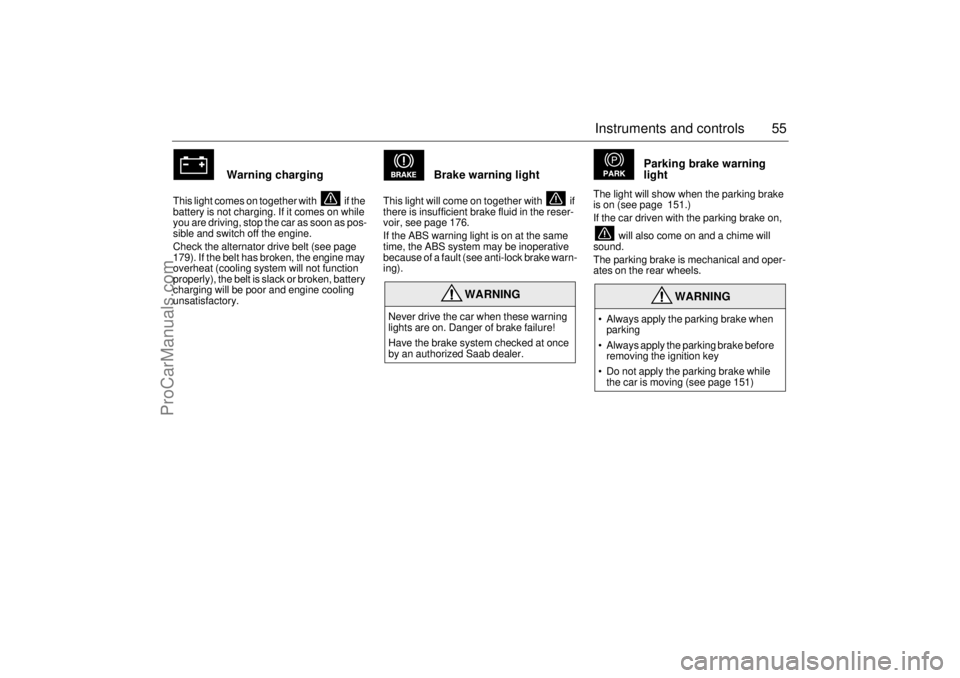
55 Instruments and controls
Warning charging
This light comes on together with if the
battery is not charging. If it comes on while
you are driving, stop the car as soon as pos-
sible and switch off the engine.
Check the alternator drive belt (see page
179). If the belt has broken, the engine may
overheat (cooling system will not function
properly), the belt is slack or broken, battery
charging will be poor and engine cooling
unsatisfactory.
Brake warning light
This light will come on together with if
there is insufficient brake fluid in the reser-
voir, see page 176.
If the ABS warning light is on at the same
time, the ABS system may be inoperative
because of a fault (see anti-lock brake warn-
ing).
Parking brake warning
light
The light will show when the parking brake
is on (see page 151.)
If the car driven with the parking brake on,
will also come on and a chime will
sound.
The parking brake is mechanical and oper-
ates on the rear wheels.
WARNING
Never drive the car when these warning
lights are on. Danger of brake failure!
Have the brake system checked at once
by an authorized Saab dealer.
WARNING
• Always apply the parking brake when
parking
Always apply the parking brake before
removing the ignition key
Do not apply the parking brake while
the car is moving (see page 151)
ProCarManuals.com